Lisa Tomoleoni Shihan (6th dan Aikikai) spent almost 15 years in Japan training at the Aikido World Headquarters and teaching Aikido professionally at a dojo in Tokyo. In addition to over 30 years Aikido experience, Lisa has black belt ranking in Judo and Iaido and is a member of the Kenshukan Dojo in Tokyo. She is Director of the Aikido Shimbokukai, an organization officially recognized by the Aikikai Foundation in Tokyo, Japan with nearly 50 member dojos, Chief Instructor of the Abiding Spirit Aikikai in Crystal Lake, IL, and an instructor at Jiai Aikido in San Diego, CA.
Lisa is also a coauthor of the book “Along the Way”, a collection of writings about training.
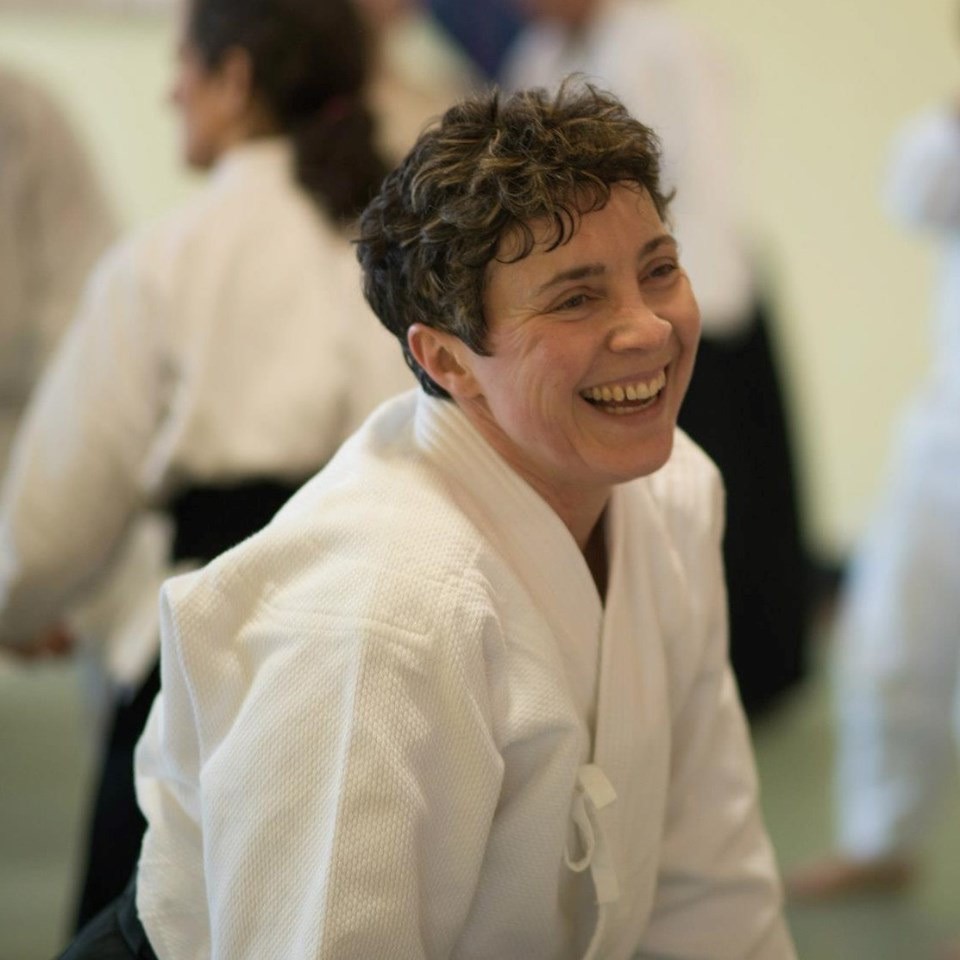
Thank you for taking the time to speak with Aikido Journal, Sensei. You lived in Japan almost 15 years. What inspired you to move there?
First off, I wanted to thank you for the opportunity to share my experiences and perspective with you and the Aikido Journal community. As to Japan – I wanted to see what Aikido was like there, where it started. My original plan was to go for one year. I didn’t speak any Japanese except for Aikido technique names, basic greetings, and “that hurts”. It was really hard at first. I eventually learned the language by studying on my own and with the help of friends.
My Iaido teacher, Takayama Takashi Sensei, was especially helpful. He would have me sit next to him whenever our group went to eat after training and teach me Japanese. He had me write “reviews” of events in the dojo and out, and he wanted them handwritten in Japanese. He would read them and return them to me the next day with notes and corrections to grammar, in red pencil. Even after I moved back to the U.S., when I wrote him letters, he would send them back with red pencil corrections.
He passed away in 2009. He was very supportive and caring, though also very strict. I miss him and think about him every day. I wish I had been a better student to him. I didn’t think so then, but I realize now that I wasted a lot of opportunities.
“I was training 8 to 10 hours a day, usually seven days a week. I had the opportunity to train with the Tokyo Metropolitan Police Special Judo Team, which was quite the education.”
But my main focus was Aikido, and in the Aikido world, I had the opportunity to be an uchideshi at Shindo Dojo, a branch dojo of Hombu Dojo in Tokyo. It was a very traditional experience. I took care of the dojo. I did the office work and published a monthly newsletter in Japanese and English. I took care of things for the chief instructor, Shindo Sensei. I did the cooking, cleaning, laundry, and gardening. I drove her when she had to go places and made sure the car was spotless. There was a pottery studio I cared for as well, and I learned about making pottery, both ceramic and clay. It was 24/7.
Yoshiko Shindo Sensei was very demanding – very old school. It was a very strict environment, very controlling. It was hard not to lose myself – to keep my sense of autonomy. I learned about putting my ego aside. I learned about awareness. I learned about timing. I learned about being detail-oriented, about customs and etiquette.
Between Aikido classes at Shindo Dojo and Hombu Dojo, and my Iaido and Judo, I was training 8 to 10 hours a day, usually seven days a week. I even had the opportunity to train with the Tokyo Metropolitan Police Special Judo Team, which was quite the education. I was, at the time, the only foreigner training on a regular basis with them, and the only white belt.

At Shindo Dojo, after some time, I was allowed to assist with classes and was later given the opportunity to teach some classes. After some years I was designated the successor to the dojo. When Shindo Sensei passed, I was to become the chief instructor of that dojo. I was legally adopted for that purpose. That was a huge honor.
So I was supposed to stay, but there came a time when I realized I needed to return to America. My mother was getting older and my sisters had children who were strangers to me. I decided that, despite my commitment in Japan, it was time to go back to the U.S.
Before leaving Japan, I went to speak with Ueshiba Moriteru Doshu to thank him for everything he had done to support me during my time in Japan. He said, “Lisa, go back to Chicago, start a dojo and connect with me.” That hadn’t occurred to me, but when Doshu says that, the only answer is “Yes, Sensei”, so I did.
Was this the inspiration behind the founding of the Aikido Shimbokukai organization?
Yes. As I started becoming more acclimated to being back in the U.S. and its Aikido community, some people wanted to join together with me. A couple years after I had returned to the U.S. my dear friend Meido Moore Shihan, who I’ve known for over 30 years, asked if I had thought about forming an organization. I hadn’t but in 2005, we began putting an organizational structure and John Burn Sensei led the build out the foundation for our tech infrastructure. After that, quite organically, more people and more dojo connected. At that time, there were basically two ways to connect with Hombu – one was through a relationship between Hombu and one individual, the other was a relationship between Hombu and an organization. Ours was the first method originally, based on my time at Hombu and teaching in Japan. However, I didn’t want it to be about me. I wanted it to be about us, the organization as a whole. So we applied for official recognition as an organization from the Aikikai, which we received in 2014. We have 47 dojo right now and about 750 members. So we’re not a large organization but we’re a happy one.
What is the organization’s top priority?
To provide a connection to the Aikikai and Home Dojo for our members, and to empower people to follow their own paths in Aikido. Our organization does not follow the style of one teacher with everyone in the same lineage. We’re not a purebred. We’re a mutt. We have people from different lineages, different backgrounds, different styles, all coming together. Nobody is saying “My style is better than your style.” The only thing that we are very adamant about is following Hombu Dojo’s ranking and organizational guidelines. Everybody supports and respects each other. I’m grateful that our organization is cohesive and there’s no drama.
“Our organization is not following the style of one teacher with everyone under the same lineage. We’re not a purebred. We’re a mutt. We have people from different lineages, different backgrounds, different styles, all coming together.”
What’s your vision for Aikido Shimbokukai?
My vision, and that of our Advisory Board and others who have helped build the organization, is to be an entity that connects people to Hombu Dojo, and gives as much guidance and input as people want without micromanaging. To provide a vehicle that empowers people to follow their own path in Aikido and evolve in the way that they wish without judgment, without controlling, and without shutting people down.
Also, to build and maintain good relationships with others in the Aikido community, and to collaborate and be of service whenever we can. For example, during the early part of the pandemic it was not possible to receive packages from Japan through the postal service. So one of our folks, Kraig Rice Sensei, organized a FedEx pickup and delivery so we could get our certificates. We reached out to other organizations and included their stuff in the shipment, and we all worked together to help the community. Doshu Moriteru Ueshiba often speaks of “Wa”, harmony. This is important to us.
Another way we build community is by organizing inter-organization seminars. Ikeda Sensei started the Bridge seminars 18 years ago at Jiai Aikido in San Diego and Shimbokukai helps with that event every year. We also host the Midwest Bridge seminar series, as well as a range of other events every year.
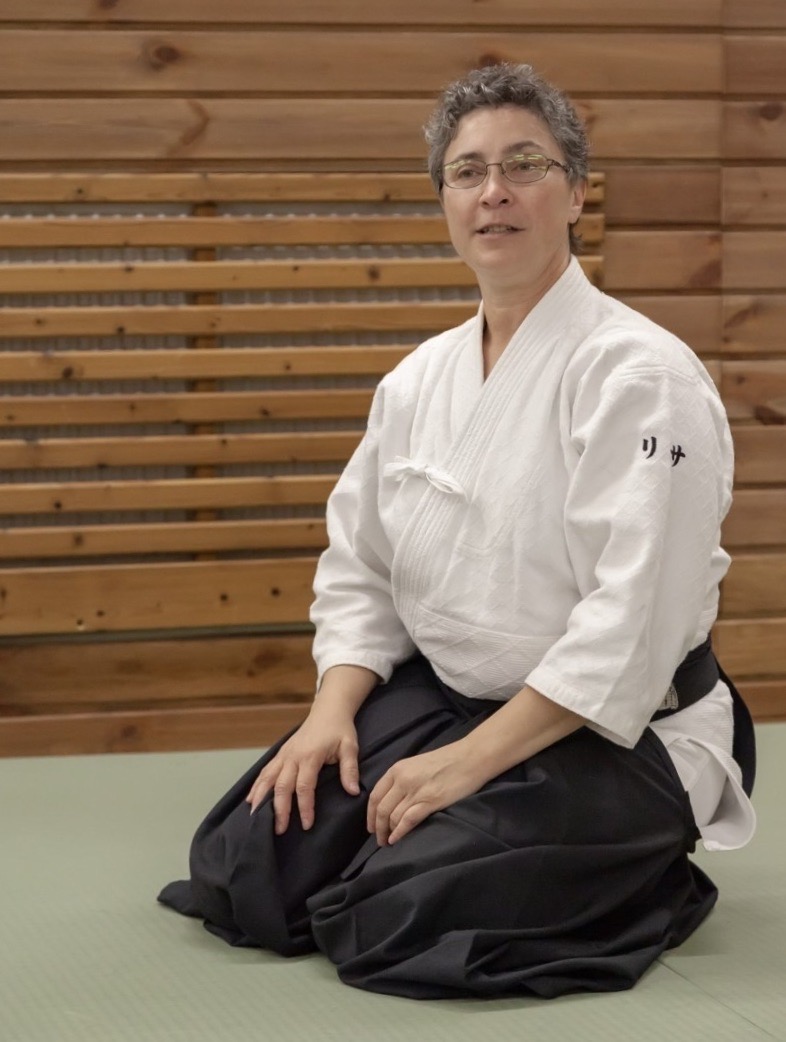
“In Shimbokukai [Ikeda Sensei is] the Vice President…When he joined, some of the people at Hombu were a little confused and I was asked by a couple instructor/staff member friends at Hombu, “is Ikeda Sensei taking over the organization?” I said “No, he’s not. We work together.”
Tell me about your relationship with Ikeda Sensei, who is your senpai in Aikido but your Vice-President. What are the dynamics like between you at the organizational level?
I treasure our relationship, even though I am not of his style and lineage. I met Ikeda Sensei a number of years ago and invited him to teach seminars at my dojo for a number of years running. At one of those seminars, he broached the topic of joining Shimbokukai.
I was so grateful for two reasons. One, I was very touched that he saw something in the organization that he liked and wanted to be a part of. And secondly, I was grateful for the opportunity to be of service to him because he does so much for the Aikido world. If I could give a little back and support him in some way, I was grateful for the opportunity to do that.
In Shimbokukai, he’s the Vice President and a member of the Grading Committee and the Advisory Board. When he joined, some of the people at Hombu were a little confused and I was asked by a couple instructor/staff member friends at Hombu, “is Ikeda Sensei taking over the organization?” I said “No. He’s not. We work together.”
You’ve been running some large-scale hybrid events recently. Can you tell us how these events started and evolved?
The pandemic has been horrible in many ways. As everyone knows, when the lockdown hit, everything shut down. In May of 2020, we organized a virtual bridge seminar with instructors from all over the world. We had about 175 attendees. It was one of the first virtual seminars that was held after the pandemic hit. The format was so successful, we’ve run many online and hybrid events since.
And when things started opening up after the pandemic, I didn’t want to abandon that format. To say, “Now we can train in person, so all you people in other parts of the world, we don’t need you anymore.” – that didn’t make sense to me. So we started doing hybrid events. Individuals could join from wherever they are and train solo, but also could gather in their dojo and train together, while receiving instruction via Zoom. And these sorts of hybrid opportunities seem to be working for people.
It’s a great way to build bridges and community. The pandemic forced everyone to get Zoom capability in their dojo, so the infrastructure is everywhere now. To be able to have people gather in their own dojo and open a window to teachers and communities in other parts of the world is wonderful.
One thing I’d like to point out is that it requires a strong team to do these larger scale events successfully. I have not done this alone. I mean, I’m really technologically-impaired. Kay Rudisill and Gary Marks are two people who have been pivotal to the success of these events. They took care of all of the technical aspects for so many events, not just for Shimbokukai but for other organizations as well. They’ve been really instrumental in keeping the Aikido community together through the pandemic. Cat Strada Sensei, chief instructor of Jiai Aikido, has also been very helpful in the running of many of these events.
“In May of 2020, we organized a virtual bridge seminar with instructors from all over the world. We had about 175 attendees. It was one of the first virtual seminars that was held after the pandemic hit. The format was so successful, we’ve run many online and hybrid events since. “
By the way, I’m very excited to work with you to create a large-scale virtual / hybrid Budo Accelerator fundraising seminar later this year. I look forward to sharing more about this in the days ahead.
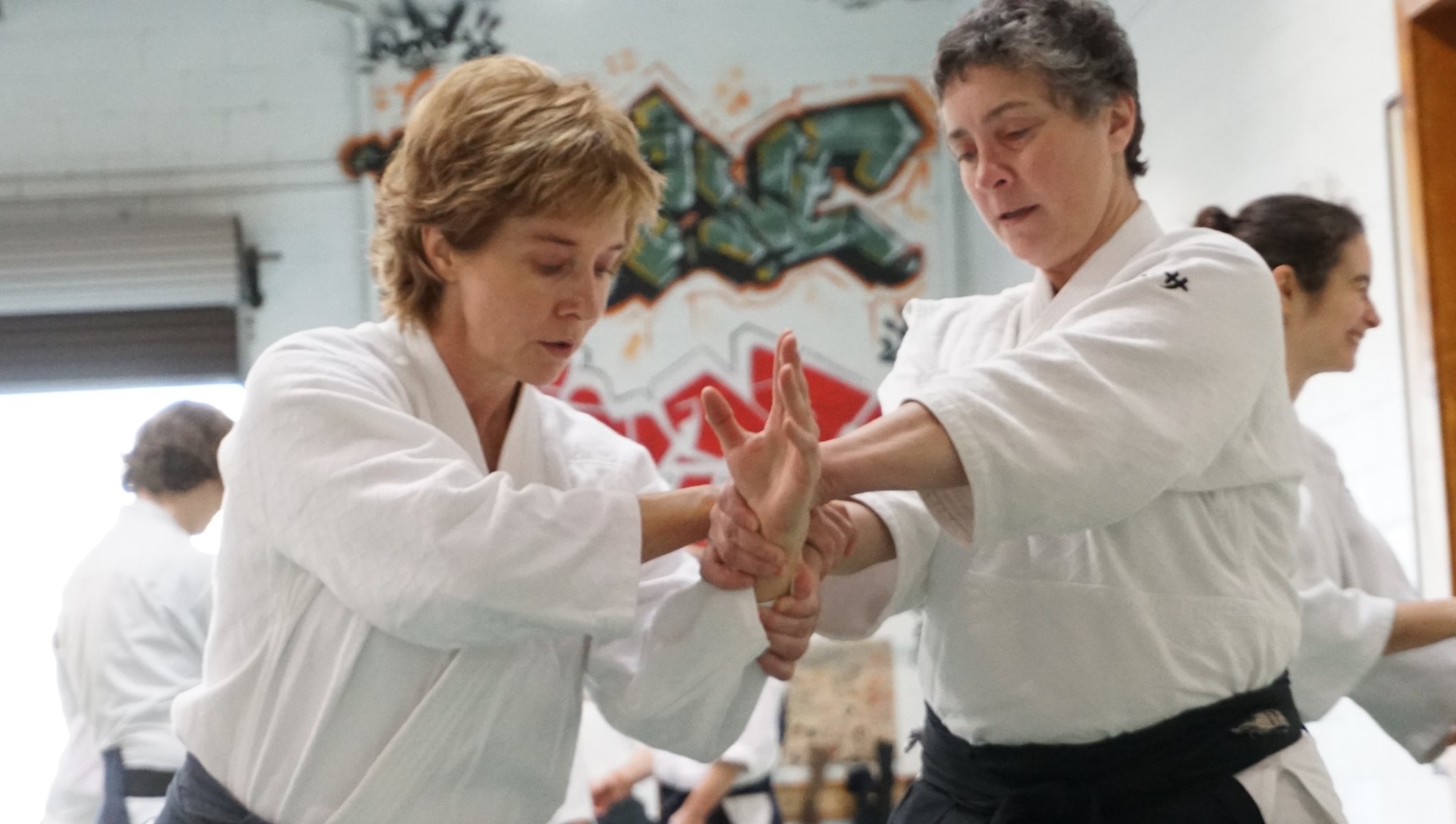
What do you think is the greatest challenge and opportunity facing the art of Aikido today?
It’s hard to pare it down to one greatest challenge, because so many things are connected… I think one issue right now is the number, age, and diversity of practitioners. In addition to having more people train, we need to reach different populations and age groups. We truly need for Aikido to become a global practice in all senses, not just from the perspective of how many different countries Aikido is practiced in.
“I think everybody should be free to pursue their own path [in Aikido] but let’s define what our individual path is, or our dojo path is, so we can be clear for ourselves, our students, and others.”
Another challenge is that people need to better clarify their path in Aikido and their dojo’s path, because there are many misconceptions about what Aikido is. There’s a broad spectrum of how Aikido can be manifested; what aspects are valued. Some people practice as a martial art for self-defense, other people practice as artistic expression, or for health, and so on.
I think it’s wonderful that there are a variety of forms of expression. I would hate to see that go away. I think everybody should be free to pursue their own path but let’s define what our individual path is, or our dojo path is, so we can be clear for ourselves, our students, and others.
How has your perspective on Aikido changed over time?
In my early days in Aikido, it was all about how hard I could throw somebody and about strong, effective techniques. But as time went by, I’ve become of the mindset that it’s about learning how to manage myself through the techniques. Of course, I want the techniques to be effective. But they are, in many ways for me now, a vehicle for learning how to manage myself physically, mentally, and emotionally. Learning how to conduct myself in a relationship with somebody else.
Is there anything else you’d like to share with the Aikido community?
First, the COVID pandemic was rough in many ways. For our community, it took its toll. A lot of people dropped away from Aikido. A lot of dojo weren’t able to stay open. Those of us who are still training, the dojo that are still in existence, everyone should be proud of themselves. Everyone should recognize how important that is and the efforts that it took to do that. It’s something to acknowledge for yourself and others, and to value.
The other thing is related to that. When I was living in Japan and training in Iaido, I went to the dojo four times a week and trained for four hours each time. I was training hard. One day, my teacher called across the floor, “Lisa-san – Go home.” I said, “What? Excuse me?” He said, “Go home. You’re not valuing your training. You’re wasting my time and yours. Pack up your stuff, change, and go home.” I was mortified. I asked him to let me say and said I would do better. he was unmoving.
Before I left, I went and bowed to him and said thank you. He told me not to come back until he called for me. He told me not even to pick up my sword or practice at home. He said not to even come to the dojo to clean.
“Let’s cherish this art of ours, keep it going, and appreciate what it gives us. Things are impermanent. Let’s all appreciate our training while we can, and have gratitude for it and each other. “
I was upset at first. “Why is he doing this to me?” Then I went home and thought about things. I realized that I had been training hard but was just going through the motions. After two weeks, my senpai called and told me Sensei wanted me to come to the dojo the next day. I got my uniform ready, packed my stuff up, made sure my sword was clean and I went back to the dojo with a new feeling.
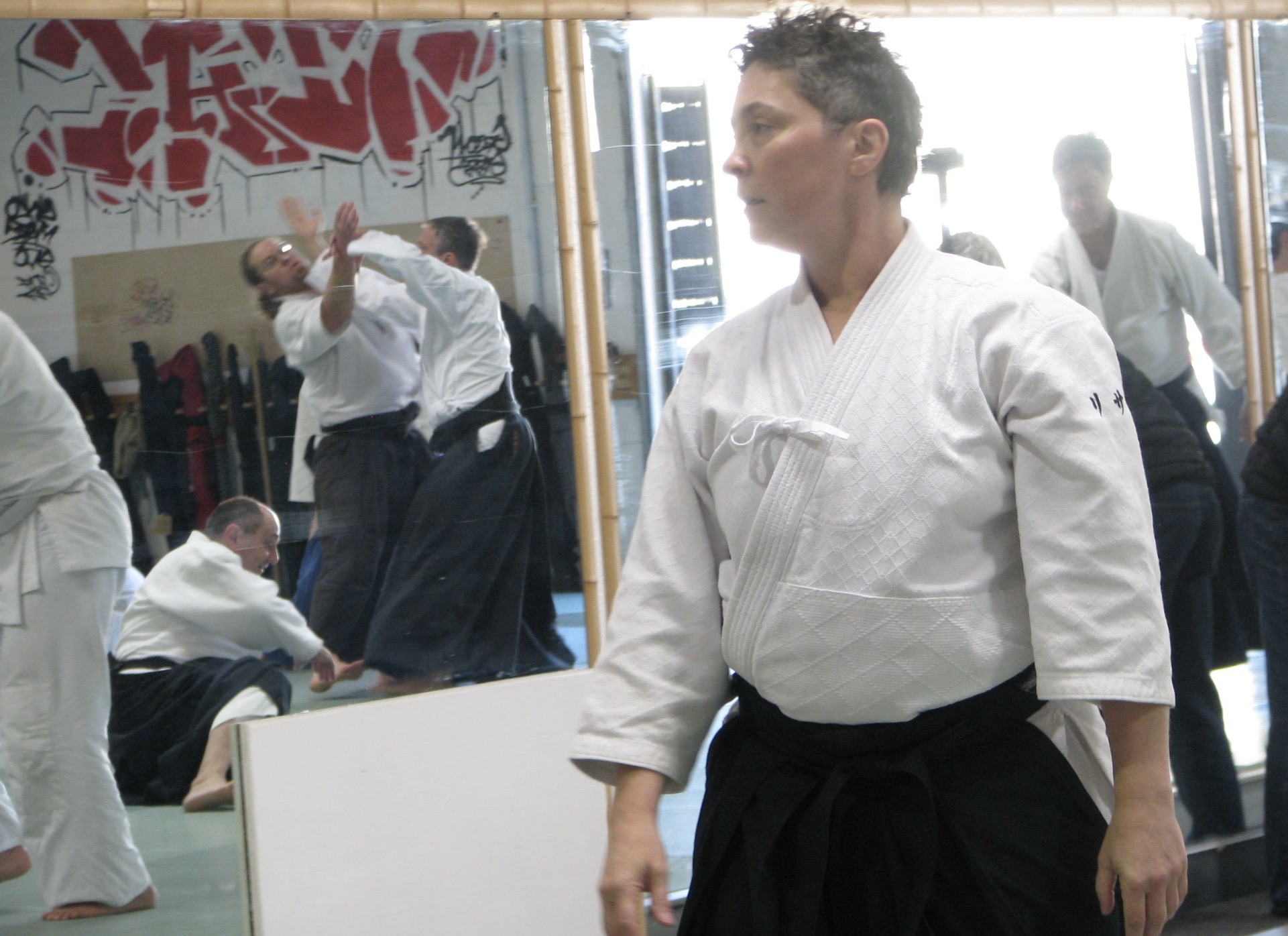
I had taken my training for granted without even realizing it. I vowed I would never do that again. And then the pandemic hit and I couldn’t get my hands on anybody to train, couldn’t be in the dojo to train, and I realized I had done it again. I had taken training for granted.
I want to invite people not to take their training for granted, not take things for granted, both inside and outside of the Aikido world. I’m suggesting we all keep this in mind, myself as well, of course. Aikido is a wonderful gift to the world and can provide opportunities for all kinds of development and change. Let’s cherish this art of ours, keep it going, and appreciate what it gives us. Things are impermanent. Let’s all appreciate our training while we can, and have gratitude for it and each other.




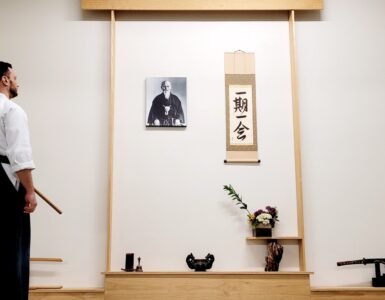








Beautiful, inspiring interview! And a wonderful call at the end, to fully appreciate the precious opportunities we have to practice Aikido. Thank you Lisa Tomoleoni Sensei and Josh Gold Sensei!
Thank you very much
for sharing your experiences, they left me a lot to think about! Thank you
Thank you for your excellent interview. I have known Lisa Sensei for many years but your article gave me a deeper understanding of her background and vision. I wish her well.
Beautiful and very understandable!
Very detailed explanation!
Hi Lisa, my name is Bill Doi, President of Kupuna Aikido.
You probably have a closer contact with our one of our former Directors, Hiroshi Kato.
I read your article on “pursuing our own path in Aikido”, and thought you might be interested in our story.
We would be honored to be able to sent a write-up about our Dojo.
To date, we have given a free presentation to over 5000 seniors regarding fall prevention and how to fall safely. We graduated over 1300 students from our 8-week HOW to fall safely classes.
Your records will show the number and rank of all of our instructors.
If interested, please contact me at [email protected] Aloha……….Bill Doi